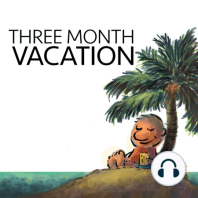4 min listen

How To Build A Cult-Like Following By Using An Adjective In Your Branding
How To Build A Cult-Like Following By Using An Adjective In Your Branding
ratings:
Length:
22 minutes
Released:
Jul 6, 2015
Format:
Podcast episode
Description
Is it really easy to build a cult-like following for your brand? Yes, but the core of that branding lies in the "adjective". Yes, that very same grammar lesson you had at school. When you look at the biggest and most well-defined brands in history, you find they are defined by a single word. Let's take Volvo, for example. The word "safety" came to mind, didn't it? That's the power of the adjective. Let's learn more in this episode of the Three-Month Vacation Details To access this audio + transcript: http://www.psychotactics.com/48 Email me at sean@psychotactics.com Twitter/Facebook: seandsouza Magic? Yes, magic: http://www.psychotactics.com/magic -------------------- In this episode Sean talks about Part 1: What is the adjective and how one little adjective can define your business? Part 2: How we get to this adjective and the biggest mistake you can make Part 3: How do we expand it further so that it becomes your whole DNA Right click here and save-as to download this episode to your computer. -------------------- Useful resources and links Free Uniqueness Series: How to find your uniqueness Uniqueness Stories: Why Uniqueness Stories Are Better Than Slogans Special Bonus: How To Win The Resistance Game The Transcript This is the Three Month Vacation. I’m Sean D’Souza. When I was growing up in India, all plywood was sold the same way. You went to a store and you picked some plywood. Then you took it home. There was no branding; it was all very, very generic. At some point, a company called Kitply, they decided that they didn’t want to be generic anymore. They decided they wanted to charge a premium on this plywood. Now why would you go and pay a premium on plywood when you could just enter the store, get your plywood just like everybody else? Well, Kitply, they wanted to do something different. That is exactly what they did. The Indian coastline, it’s about 7,000 kilometers; that’s about 4,500 miles. When you have a coastline that is so extensive, it also means that you have a lot of water around you. Water means humidity, and humidity means disaster for plywood, at least the plywood that you were getting in the store at that point in time. After you spent all this money on a carpenter, which is what most people did, they got a carpenter across and they built cupboards and they put the plywood in the cupboards. Then the rains would come. In India, you don’t just get rains; you get rains in June, all of July, all of August, and a bit in September as well. That plywood would get all the moisture sitting in it. After a while, it would start to warp. Your beautiful cupboard, all your furniture, it would have this warped plywood. It would drive people crazy, but there was nothing that you could do until Kitply came up with a solution. They made their plywood waterproof. But Indians are a skeptical lot, and rightly so. If you’ve got a monsoon that goes on for several months, you want to be sure that the plywood is exceedingly good. So, Kitply not only said that their plywood was waterproof, but that it was boiling waterproof. Now no one was going to take boiling water and throw it on the plywood, but it made a point. What is the factor that caused Kitply to stand out? Incredibly, we have to go back to a grammar lesson, because what we’re doing here is just looking at the adjective. What we’re going to cover in this podcast are three elements. First is what is the adjective. Second: how to pick it. Third: how to refashion your product around it. Let’s start off with the first one, which is what is the adjective. Part 1: What is the Adjective Now, I don’t have to tell you what an adjective is. You did that in grammar class. But here’s the point. When we started out the article writing course it was very difficult for us to position it against other article writing courses, because ours is almost $3,000 and, well, the others are $400 and $500. Some are even free. What we did was we put one little adjective. We c
Released:
Jul 6, 2015
Format:
Podcast episode
Titles in the series (100)
Book Recommendation: The Talent Code: Why did we have so many great artists, painters and sculptors in the Renaissance? Why does Brazil produce so many great soccer players? Is slow learning better than fast? Learn more by reading "The Talent Code" by Daniel Coyle. / / For more:... by The Three Month Vacation Podcast